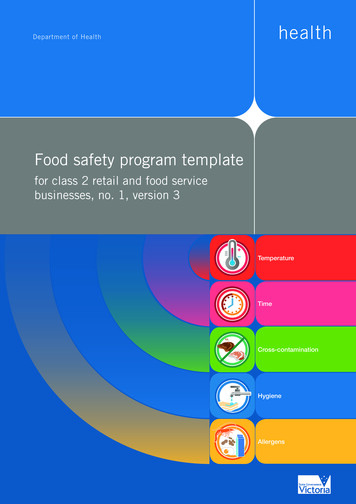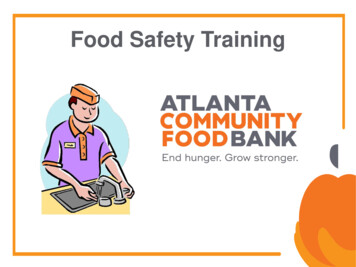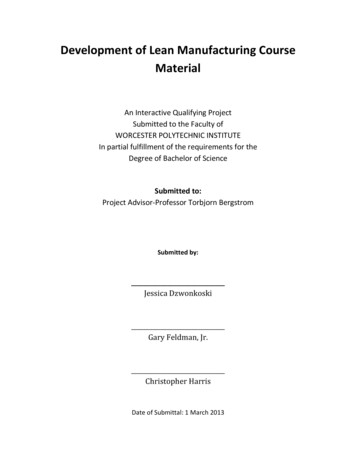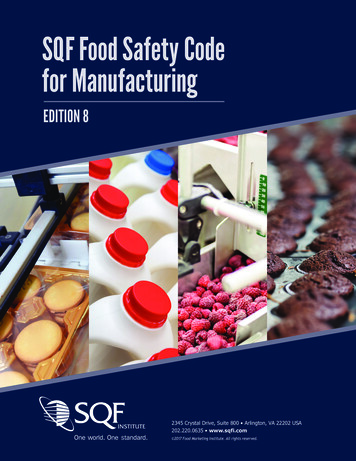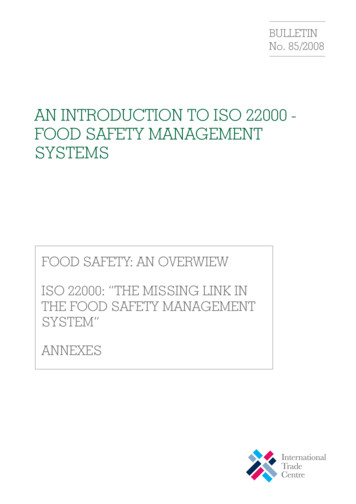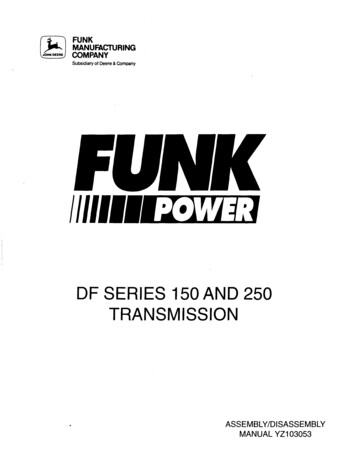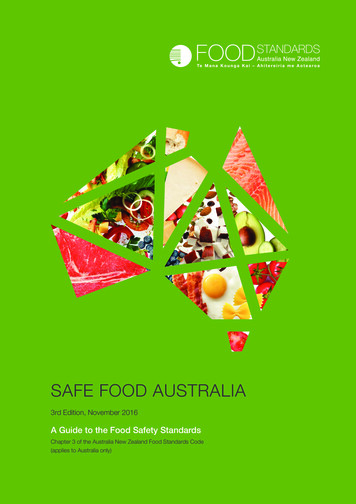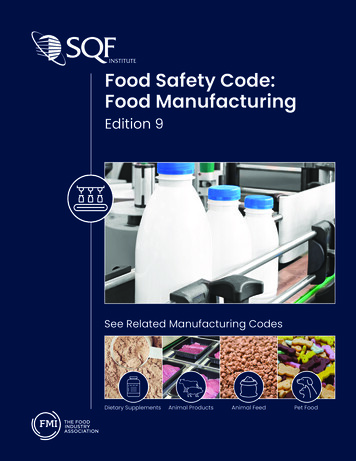
Transcription
Food Safety Code:Food ManufacturingEdition 9See Related Manufacturing CodesDietary SupplementsAnimal ProductsAnimal FeedPet Food
About SQFISQFI is a division of FMI, established to administer the SQF Program, a leading, global foodsafety, and quality certification and management system. Our mission is to deliver consistent,globally-recognized food safety and quality certification programs based on sound scientificprinciples, applied across all industry sectors and valued by all stakeholders. www.sqfi.comAbout FMIAs the food industry association, FMI works with and on behalf of the entire industry toadvance a safer, healthier and more efficient consumer food supply chain. FMI brings togethera wide range of members across the value chain — from retailers that sell to consumers, toproducers that supply food and other products, as well as the wide variety of companiesproviding critical services — to amplify the collective work of the industry. www.fmi.orgCopyright 2020FMIAll rights reserved. This publication may not be reproduced, stored in any information orretrieval system or transmitted in whole or part, in any form or by any means—electronic,mechanical, photocopying, recording or otherwise—without the express written permissionof FMI.For permission contact FMI at www.fmi.org, or 2345 Crystal Drive, Suite 800, Arlington, VA,22202, USA. Care should be taken to ensure current edition of the Code is used and thatmaterial be updated whenever the Code is amended or revised. The date of the Code shouldbe clearly identified in materials.First Printed May 1995.SQF Code, Edition 9 improvement suggestions are encouraged from all parties. Writtencomments should be sent to SQFI at 2345 Crystal Drive, Suite 800, Arlington, VA, 22202, USA.SQF Food Safety Code: Food Manufacturing, Edition 92
SQFIOne World. One Standard.Globalization has revolutionized the food supply chain. This globalization has brought manycompanies a whole world of opportunities but also more risks. Consumers and retailers aredemanding the highest levels of safety, quality, and responsibility from companies. Theyexpect companies to follow all the stringent industry and regulatory standards. The SQF (SafeQuality Food) Institute is your trusted partner to achieve universal recognition of the safetyand quality of your products, services, and processes.At SQFI, our goal is always food safety and quality – and we are dedicated to writing arigorous standard and developing comprehensive training, cohesive guidance materials, andfree educational resources to help you along the way. Success does not happen in a vacuum,and neither does food safety. Together, we can help to build a safer supply chain, one foodproducer at a time.SQF Code Edition 9SQFI has updated the SQF Code from Edition 8.1 to Edition 9 to:1.Consolidate requirements to create a simpler, more streamlined experience without a negative2.Meet updated GFSI requirements for implementation beyond 2020.impact on standard integrity.SQF Edition 9 comes with several enhancements and improvements to the Code structure,methodology, and technical requirements. From dietary supplements to pet food, severalprimary and manufacturing industries now have dedicated Codes to provide a more specificset of requirements and risk assessment for each.All enhancements made to the SQF Codes are to build a better overall audit experience thatadds even more value to SQF certification.The SQFI CommitmentSQF certification assesses and assures the implementation of a site’s food safety and qualityplan and confirms the site has the necessary tools and training to manage food safety andquality.A site’s achievement of SQF food safety certification indicates a commitment to:1.Produce safe, quality food.3.Comply with applicable food legislation.2.Comply with the requirements of the SQF Code.By implementing an SQF Food Safety Management System, sites become equipped toaddress a buyer’s food safety and quality requirements. The SQF Code provides a solution forbusinesses supplying local and global food markets. Products produced and manufacturedvia the SQF Code certification process retain a high degree of acceptance in global markets,benefiting both certified sites and their customers.SQF Food Safety Code: Food Manufacturing, Edition 93
About the SQF ProgramThe SQF Program was first developed in Australia in 1995 and has been owned and managedby FMI, The Food Industry Association, since 2003. In 2004, GFSI first recognized our standardas one that meets its benchmark requirements.SQFI VisionTo be the single most trusted source for global food safety and quality certification.SQFI MissionOur mission is to deliver consistent, globally-recognized food safety and quality certificationprograms based on sound scientific principles, applied across all industry sectors and valuedby all stakeholders.Contact SQFIAt SQFI, we incorporate retailer and stakeholder feedback to address the many global foodsafety, and quality issues society faces every day. We recognize pursuing a certificationprogram for your business is a big commitment – regardless of your food safety and qualityexperience levels.Visit www.sqfi.com for the SQF certified site directory, SQF guidance, tip sheets and checklists,training opportunities, tools to find a certification body and to register in the SQFI assessmentdatabase.The SQFI assessment database is an audit management and data capture solutiondeveloped to contain costs and improve the efficiency and effectiveness of food safetyaudits. This innovative technology represents significant progress in how audit data iscaptured, managed and made available, and sets the SQF program apart from other similarGFSI programs.Customer Service – info@sqfi.com 202-220-0635 1-877-277-2635Database Assistance – info@sqfi.comCompliance – compliance@sqfi.comDisclaimersCertification of a site’s SQF System by a Safe Quality Food Institute licensed certifyingbody does not guarantee a site’s product safety or constant adherence to all food safetyregulations.This reference document is published in English and is available in several other languages.If the translated content differs, the original English version is to be referenced for finalinterpretation.Feel free to use the Glossary included in the Appendix for further context and clarification ofterminology used in this document.SQF Food Safety Code: Food Manufacturing, Edition 94
ContentsPART A: Implementing and Maintaining the SQF Food Safety Code:Food Manufacturing.7A1: Food Sector Categories in This Code.8A2: Steps to Achieving SQF Certification (steps 1 – 10). 11Step 1: Register on the SQFI Assessment Database.13Step 2: Designate an SQF Practitioner.132.1Training (optional).133.1Exemptions.15Step 3: Determine the Scope of Certification. 14Step 4: Document Your SQF System.154.1 Applicable Elements.154.2 Mandatory Clauses.16Step 5: Implement Your SQF System.16Step 6: Pre-assessment Audit (optional).16Step 7: Select a Certification Body. 177.1Select the SQF Auditor.17Step 8: The Initial Certification Audit .188.1 Audit Duration. 208.2 Corporate Audits. 208.3 Seasonal Production. 20Step 9: Audit Reporting and Close-out.209.1Non-conformances . 209.2 Audit Score.219.3 Reviewed Audit Report.229.4 Corrective Actions.22Step 10: Granting Certification. 2310.1 Certificate Issue. 2410.2 Failure to Comply. 2410.3 Appeals and Complaints. 25A3: Maintaining Your SQF Certification (steps 11 - 15). 26Step 11: Re-certification.2611.1 Re-certification Audits.2711.2 Variations from the Initial Certification Process.2711.3 Re-certification Audits – Seasonal Operations.2711.4 Unannounced Audits.27Step 12: Surveillance Audits.2812.1 Surveillance Audit – Seasonal Operations. 29Step 13: Suspending Certification. 2913.1 Reporting Suspension. 29Step 14: Withdrawing Certification.31SQF Food Safety Code: Food Manufacturing, Edition 95
Step 15: Changes to Site SQF Requirements. 3215.1 Temporary or Permanent Change of Audit Dates.3215.2 Changing the Scope of Certification.3215.3 Changing the Certification Body.3315.4 Relocation of Premises.3315.5 Change of Business Ownership. 3415.6 Notification of Recalls and Regulatory Infringements. 3415.7 Use of a Technical Expert. 3415.8 Language Used During the Audit. 3515.9 The SQFI Compliance and Integrity Program. 35PART B: The SQF Food Safety Code: Food Manufacturing. 362.1Management Commitment.372.2 Document Control and Records. 392.3 Specifications, Formulations, Realization, and Supplier Approval. 402.4 Food Safety System. 432.5 SQF System Verification . 482.6 Product Traceability and Crisis Management. 502.7 Food Defense and Food Fraud. 522.8 Allergen Management . 532.9 Training. 54Module 11: Good Manufacturing Practices for Processing of Food Products. 5611.1 Site Location and Premises. 5611.2 Site Operation. 6011.3 Personnel Hygiene and Welfare. 6411.4 Personnel Processing Practices. 6711.5 Water, Ice, and Air Supply. 6811.6 Receipt, Storage, and Transport.7011.7 Separation of Functions.7311.8 Waste Disposal.75APPENDIX 1: SQF Food Sector Categories. 77APPENDIX 2: Glossary. 86APPENDIX 3: SQF Logo Rules of Use. 100APPENDIX 4: Requirements for SQF Multi-site Certification . 102SQF Food Safety Code: Food Manufacturing, Edition 96
PartAImplementing and Maintainingthe SQF Food Safety Code:Food ManufacturingSQF Food Safety Code: Food Manufacturing, Edition 97
PART A: Implementing and Maintaining the SQF Food Safety Code: Food ManufacturingA1: Food Sector Categories inThis CodeFOOD SECTOR CATEGORYAPPLICABLE GMP MODULES10Dairy Food ProcessingModule 11: GMP for Processing of Food Products11Honey ProcessingModule 11: GMP for Processing of Food Products12Egg ProcessingModule 11: GMP for Processing of Food Products13Bakery and Snack Food ProcessingModule 11: GMP for Processing of Food Products14Fruit, Vegetable, and NutProcessing, and Fruit JuicesModule 11: GMP for Processing of Food Products15Canning, UHT, and Aseptic OperationsModule 11: GMP for Processing of Food Products16Ice, Drink, and Beverage ProcessingModule 11: GMP for Processing of Food Products17Confectionery ManufacturingModule 11: GMP for Processing of Food Products18Preserved Foods ManufacturingModule 11: GMP for Processing of Food Products19Food Ingredient ManufacturingModule 11: GMP for Processing of Food Products20Recipe Meals ManufacturingModule 11: GMP for Processing of Food Products21Oils, Fats, and the Manufacturingof Oil or Fat-based SpreadsModule 11: GMP for Processing of Food Products22Processing of Cereal GrainsModule 11: GMP for Processing of Food Products25Repackaging of Products NotManufactured On SiteModule 11: GMP for Processing of Food Products33Food Processing Aids ManufacturingModule 11: GMP for Processing of Food ProductsThe Safe Quality Food Institute (SQFI) publishes a suite of globally recognized food safetyand quality codes that cover all aspects of the food supply chain from primary productionthrough to retail and foodservice. All standards are available free of charge at www.sqfi.com.Before embarking on the SQF journey, sites are encouraged to download and review the SQFcode that best fits their needs.SQF Food Safety Code: Food Manufacturing, Edition 98
PART A: Implementing and Maintaining the SQF Food Safety Code: Food ManufacturingFood Safety FundamentalsSQF Fundamentals for PrimaryAll Primary food sector categories (FSCs)SQF Fundamentals for PrimaryAll Primary food sector categories (FSCs)SQF Fundamentals for ManufacturingAll Manufacturing and Storage and Distribution food sectorSQF Fundamentals for ManufacturingAll Manufacturing and Storage and Distribution food sectorProduction - BasicProduction – Intermediate- Basic– Intermediatecategories (FSCs)categories (FSCs)HACCP-based Food Safety Codes*Denotes SQF Food Safety Codes that are GFSI benchmarkedPrimary ProductionThe SQF Food Safety Code: PrimaryFSC 1: Production, Capture, and Harvesting of Livestock andThe SQF Food Safety Code: PrimaryFSC 2: Indoor Growing and Harvesting of Fresh Produce andAnimal Production*Plant Production*Game Animals, and ApicultureSprouted Seed Crops (NEW!)FSC 3: Growing and Production of Fresh Produce and NutsFSC 4: Fresh Produce, Grain, and Nut Packhouse OperationsFSC 5: Extensive Broad Acre Agricultural OperationsThe SQF Food Safety Code:AquacultureFSC 6: Intensive Farming of SeafoodManufacturingThe SQF Food Safety Code: FoodManufacturing*This Code covers the food safetyrequirements for the FSC(s) to therightFSC 10: Dairy Food ProcessingFSC 11: Honey ProcessingFSC 12: Egg ProcessingFSC 13: Bakery and Snack Food ProcessingFSC 14: Fruit, Vegetable, and Nut Processing, and Fruit JuicesFSC 15: Canning, UHT, and Aseptic OperationsFSC 16: Ice, Drink, and Beverage ProcessingFSC 17: Confectionery ManufacturingFSC 18: Preserved Foods ManufacturingFSC 19: Food Ingredient ManufacturingFSC 20: Recipe Meals ManufacturingFSC 21: Oils, Fats, and the Manufacturing of Oil or Fat-basedSpreadsFSC 22: Processing of Cereal GrainsFSC 25: Repackaging of Product Not Manufactured On-siteFSC 33: Food Processing Aides ManufacturingThe SQF Food Safety Code: AnimalProduct Manufacturing*FSC 7: Slaughtering, Boning, and ButcheryFSC 8: Manufactured Meats and PoultryFSC 9: Seafood ProcessingSQF Food Safety Code: Food Manufacturing, Edition 99
PART A: Implementing and Maintaining the SQF Food Safety Code: Food ManufacturingThe SQF Food Safety Code: DietaryFSC 31: Dietary Supplements ManufacturingThe SQF Food Safety Code: Pet FoodFSC 32: Pet Food ManufacturingThe SQF Food Safety Code: AnimalFSC 34: Animal Feed ManufacturingSupplements Manufacturing*Manufacturing*Feed Manufacturing*Food PackagingThe SQF Food Safety Code:Manufacture of Food Packaging*FSC 27: Manufacture of Food PackagingStorage and DistributionThe SQF Food Safety Code:Storage and Distribution*FSC 26: Storage and DistributionRetailThe SQF Food Safety Code: Food RetailFSC 24: Food RetailingFoodserviceThe SQF Food Safety Code:FoodserviceFSC 23: Food Catering and FoodserviceHACCP-based Food QualityQualityThe SQF Quality CodeApplies to all GFSI-recognized and equivalent standards andother Food Safety Management Standards including HACCPcertification and ISO 22000SQF Food Safety Code: Food Manufacturing, Edition 910
PART A: Implementing and Maintaining the SQF Food Safety Code: Food ManufacturingA2: Steps to Achieving SQFCertification (steps 1 – 10)The SQF Food Safety Code: Food Manufacturing sets out the implementation, maintenance,and technical requirements for sites involved in the manufacture, processing, packaging,storage, and transport of all types of plant-based products, mixed animal and plant-basedproducts, and ambient stable products. Part A (this part) sets out the steps you need to take to implement and maintain certification tothe SQF Food Safety Code: Food Manufacturing, and Part B is the auditable standard. It details the SQF System elements for food manufacturingthat must be met (module 2), and the relevant Good Manufacturing Practices (GMP) for foodmanufacturing (module 11).If you are in a site management or technical role and are responsible for implementing therequirements of the SQF Food Safety Code: Food Manufacturing, you can learn how to getstarted and implement your SQF System in several ways. SQFI has an online “Implementing SQF Systems” training course, which can be accessed fromsqfi.com. It is a web-based education tool where you can enroll and complete SQF Systemstraining in your own time and at your own pace. An “Implementing SQF Systems” training course is available through the SQFI network of licensedtraining centers. Details about the training centers and the countries in which they operate areavailable at sqfi.com. Although training is recommended, you can train yourself by downloading the SQF Food SafetyCode: Food Manufacturing from sqfi.com free of charge and applying it to your industry sector,site, and processes. Your management may choose to utilize the services of a registered SQF consultant. All SQFconsultants are registered by SQFI to work in specific food sector categories (FSCs) and areissued with an identification card indicating the FSCs in which they are registered. The criteriaoutlining the requirements necessary to qualify as an SQF consultant and the application formsare available at sqfi.com. The SQF Consultant Code of Conduct outlines the practices expectedof SQF consultants. Guidance documents are available for some SQF Codes and FSCs from sqfi.com. Thesedocuments can help you interpret the requirements of the SQF Codes and assist withdocumenting and implementing an SQF System. The documents are developed with theassistance of food sector technical experts. The guidance documents are available to assist youbut are not auditable documents. Where there is a divergence between the guidance documentand the SQF Food Safety Code: Food Manufacturing, the SQF Code prevails.SQF Food Safety Code: Food Manufacturing, Edition 911
PART A: Implementing and Maintaining the SQF Food Safety Code: Food ManufacturingThe steps in achieving SQF certification are as follows:Step 1: Register on the SQFIAssessment DatabaseStep 2: Designate an SQFPractitionerStep 3: Determine theScope of CertificationStep 4: Document your SQFSystem2.1 Training(optional)3.1 Exemptions4.1 ApplicableElements4.2 MandatoryElementsStep 5: Implement yourSQF SystemStep 6: Pre-assessmentAudit (optional)Step 7: Select aCertification BodyStep 8: The InitialCertification AuditStep 9: Audit Reportingand Closeout7.1 Select the SQFAuditor8.1 Audit Duration9.1 Non-conformances8.2 CorporateAudits9.2 Audit Score8.3 SeasonalProduction9.3 Reviewed AuditReports9.4 CorrectiveActionsStep 10: GrantingCertification10.1 Certificate IssueSQF Food Safety Code: Food Manufacturing, Edition 910.2 Failure toComply10.3 Appeals andComplaints12
PART A: Implementing and Maintaining the SQF Food Safety Code: Food ManufacturingStep 1: Register on the SQFI Assessment DatabaseTo be considered for SQF certification, you are required to register your site on the SQFIassessment database. The database can be accessed at sqfi.com.There is a fee for each site, payable at registration and annual renewal. The fee scale isdependent on the size of the site, as determined by gross annual sales revenue and byindustry sector. The fee scale is available at sqfi.com.You need to register your site with SQFI prior to the start of the initial certification auditand remain registered at all times to retain your site certification. If you do not maintainregistration, the site certificate will be invalid until the site is properly registered on the SQFIassessment database.Step 2: Designate an SQF PractitionerThe SQF Food Safety Code: Food Manufacturing requires that every certified site has asuitably qualified SQF practitioner to oversee the development, implementation, review,and maintenance of the SQF System, including the system elements, Good ManufacturingPractices (GMPs), and food safety plans. The requirements for an SQF practitioner aredescribed in the system elements, Part B: 2.1.1.4 and 2.1.1.5.You may choose to have more than one SQF practitioner to meet shift and operationalrequirements.An alternative staff member should also be identified to manage the SQF System in theabsence of the designated SQF practitioner.2.1 Training (optional)An “Implementing SQF Systems” training course is available online and through the SQFInetwork of licensed training centers. SQF practitioners, who are responsible for designing,implementing, and maintaining the requirements of the SQF Food Safety Code: FoodManufacturing, are encouraged to participate in a training course. The “ImplementingSQF Systems” training course is not mandatory for SQF practitioners but is stronglyrecommended.Details of the training courses are available at sqfi.com.SQF practitioners are required to successfully complete HACCP training that is a minimumtwo-day duration and assessed.Training in other food industry disciplines, Good Manufacturing Practices (GMP), and InternalAuditing may also be beneficial, and licensed SQF training centers can provide details aboutthe other training courses they provide.SQF Food Safety Code: Food Manufacturing, Edition 913
PART A: Implementing and Maintaining the SQF Food Safety Code: Food ManufacturingStep 3: Determine the Scope of CertificationBefore implementing the SQF Code, you must decide the scope of certification - in otherwords, the food sector categories, products, and processes to be included in your SQFSystem.The scope of certification determines which elements of the SQF Food Safety Code: FoodManufacturing are to be documented and implemented and will be audited by thecertification body. The scope needs to be agreed upon between your site and the certificationbody before the initial certification audit and cannot be changed during or immediatelyfollowing a certification or re-certification audit.The scope of certification specifies: The site. SQF certification is site specific. The entire site, including all premises, support buildings,silos, tanks, loading and unloading bays, and external grounds are identified and included in thescope of certification.If activities are carried out in different premises but are overseen by the s
Quality Food) Institute is your trusted partner to achieve universal recognition of the safety and quality of your products, services, and processes. At SQFI, our goal is always food safety and quality - and we are dedicated to writing a rigorous standard and developing comprehensive training, cohesive guidance materials, and

